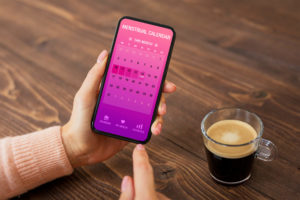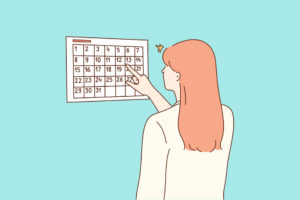Menstrual Cycle Phases: You might think that your period starts and ends when you bleed, but the reality is that the female menstrual cycle is present all month long. It includes four distinct phases, which we will explore in today’s article. Knowing and honoring which phase of the menstrual cycle you are in will help you achieve vibrant health and much more.
![]()
This article has been medically reviewed by Dr. Charles Penick, MD![]()
Reframing the Menstrual Cycle
For many women, the topic of menstrual health is full of shame. Periods are usually something most women try to hide or ignore. With fertility problems on the rise, there is also frustration with symptoms of PMS and conditions like PCOS, endometriosis, and fertility. The thought that the menstrual cycle could be empowering is a stretch (at best) for most women.
What if we told you that all the health conditions you associate with your period might be the gateway towards reconnecting with your body and empowering your life? Reframing your relationship to your menstrual cycle does not necessarily happen overnight, but with the right tools and attention, you can transform this relationship to help you thrive.
Charting your Cycle

To start connecting more deeply with your body and menstrual cycle, learn to chart your menstrual cycle. There are various methods you can use, including the sympto-thermal method. Learning to chart correctly often requires a coach who should teach you how to chart in 1-3 sessions. By taking your temperature at the same time every morning and observing bodily sensations, you note down the information daily and can register when you ovulate. As you will learn below, the other phases are marked by the start and end of your bleed and the times on either side of ovulation.
Cycle Synching
Once you know how to chart your menstrual cycle properly, you will gain a wealth of information about your body. One data set includes which phase of your menstrual cycle you are in, consisting of four stages: the menstruation, follicular, ovulation, and luteal phase.
Each phase has distinct physiological characteristics that have an enormous impact on how you feel day to day. The phases themselves have marked the biological cycle of your menstrual cycle.
Menstruation Phase
Your menstrual phase starts on the first day of your bleed and lasts until the last day of your bleed. Typically this phase is two to seven days long 1. Hormonally, this is the most depleted state in your cycle 2. The menstruation phase requires the most rest, so it’s a good idea to slow down in all areas of your life. Honoring this phase means less social engagements, less exercise, and more nutrient-dense foods.
The menstruation phase mirrors the dark moon phase of the lunar cycle. It is a great time to go inwards and set a new intention for the upcoming month for what you want to call in and create in your life. It is also an excellent time to let go of what no longer serves you. Journalling on these two things (what you want to let go of and what you want to call in) is a fantastic exercise during the first few days of your cycle.
Follicular Phase
The follicular phase begins after your bleed ends and is marked by a rise in estrogen 2. The increase in estrogen brings more energy, expression, and extroversion. This is the time of the month to move more, eat lighter, and schedule more social activities.
The follicular phase also ramps libido when women tend to feel more sensual and confident. You could harness this power by going on a date, throwing or attending a party, or penciling in a job interview or big presentation.
The follicular phase mirrors the waxing moon stage and is ideal for focusing and working hard on your new intention. You have the energy and drive to focus and go out into the world to get it done! This is the time of the month to conquer the do-to list.
Ovulation Phase
The follicular phase rise in estrogen peaks with ovulation when your ovaries release an egg 2. This time of the month is when energy peaks too and is a turning point from extroversion into introversion. Ovulation is when, if sperm is present, a woman can become pregnant and create a human being. That creation energy, however, isn’t limited to creating life. Women can harness this sexual and creative energy towards any project. So leading up to ovulation and peaking at this point is your time to birth things into the world.
This phase mirrors the full moon when you are at your fullest. Enjoy the energy, the desire to connect, be around people, be playful, and love life.
Luteal Phase
After you ovulate, the luteal phase begins and lasts until the first day of your bleed. After ovulation, estrogen drops, and testosterone rises 2. This results in less energy, more introspection, and less desire to do and achieve. Honoring this phase calls for slowing down, spending less time in big crowds or outside the house, and getting your life to prepare for a deep rest while you bleed.
This is the ideal time of the month to increase carbohydrates regarding diet variation. Increasing carbs in the five or so days before your period can help ease PMS and pain during your cycle. It’s also an excellent time to increase your magnesium intake, which is why many PMS cravings revolve around magnesium-rich cacao!
Although PMS symptoms commonly mark this phase, the reality is that it is not normal or healthy. Experiencing intense mood swings or pain may signify that there’s something off hormonally 3. Many women experience estrogen dominance, which can cause a wide range of undesirable symptoms.
This phase mirrors the waning moon, a time to reflect on your intention and the month you just experienced. How did you show up? In what ways did you honor your body or not? How might you adjust for next month, and what intentions might you set during your next period?
If You Aren’t Bleeding
For the women who aren’t bleeding (either due to amenorrhea, menopause, or any other reason), you can still connect to the cyclical energies of the feminine by tuning in to the lunar cycle. Each of the four cycles mentioned above is directly related to the moon, so if you don’t bleed, the moon can guide your cyclical lifestyle.
Honoring the Phase You’re In

Although there are common ways in which most women operate during the four phases, you may also have your bio-individual relationship to any of the four menstrual cycle phases. Knowing how to best honor your phase requires tuning in and understanding what your body needs in each phase.
One way to tune in is to keep a daily journal, where you jot down how you feel emotionally, physically, spiritually, and sexually. For example, do you feel introverted or extroverted? How is your libido? Are you feeling creative or stagnant? Energetic or inclined to slow down? Over time, you will start to notice a trend and can begin to plan and schedule your life to honor your capacity during each phase.
For many women, the follicular phase is a time of more energy and extroversion; this is the time to make social plans, schedule interviews, or give a presentation. On the other hand, the luteal phase is a time to slow down and be more creative; this could be when you schedule a pottery class or make plans to tidy up your house.
Understanding the cyclical phases of your libido during your menstrual cycle can also help you communicate with your partner and find ways to honor your body. For example, you may schedule a date night during your follicular phase instead of during your luteal phase.
Honoring and Loving Your Body

The shame that surrounds menstruation extends itself to body shame for many women. One way to reclaim this is to start honoring your sexual self and the parts of you that are typically hidden in shame.
Using a mirror to look at the parts of your body that you may have never looked at, or spend a lot of time trying to cover up, is a good start. Then, can you speak lovingly to these parts of yourself and treat them with the same unconditional love you would have for your child?
A self-pleasure practice is also a great way to connect and develop a love for your body. Sex and sexuality are considered taboo in general, but especially for women. As a result, we often dissociate from our sexual selves and don’t take the time to be with this part of us, honoring it and bringing it pleasure.
Summary
The menstrual cycle is often filled with shame and pain, leading many women to feel disempowered by their bodies. Learning how to chart your cycle and understand the phases of your menstrual cycle can help you turn this monthly process into a profoundly empowering experience. Each of the four phases has its own distinct way of being honored. By learning about the menstrual, follicular, ovulation, and luteal phases (which mirror the moon cycles for women who aren’t currently bleeding), you can connect more deeply with your body and thrive.
Medical Disclaimer: The information on this website is not intended to replace a one-on-one relationship with a qualified health care professional and is not intended as medical advice. It is intended to share knowledge and information. This article has been medically reviewed by Dr. Charles Penick, MD, for the accuracy of the information provided, but we encourage you to make your own healthcare decisions based upon your research and in partnership with a qualified healthcare professional.
References
- “Menstrual Cycle: What’s Normal, What’s Not.” Mayo Clinic, Mayo Foundation for Medical Education and Research, 29 Apr. 2021, https://www.mayoclinic.org/healthy-lifestyle/womens-health/in-depth/menstrual-cycle/art-20047186.
- Reed BG, Carr BR. The Normal Menstrual Cycle and the Control of Ovulation. [Updated 2018 Aug 5]. In: Feingold KR, Anawalt B, Boyce A, et al., editors. Endotext [Internet]. South Dartmouth (MA): MDText.com, Inc.; 2000-. Available from: https://www.ncbi.nlm.nih.gov/books/NBK279054/
- Briden, Lara. Period Repair Manual. Pan Macmillan Australia, 2018.


